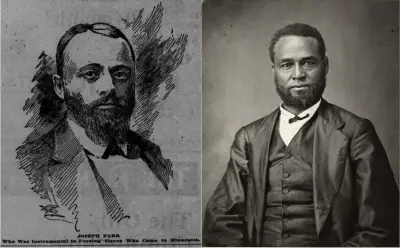How Minnesotans aided the Underground Railroad and freedom seekers

Although long ignored in Underground Railroad scholarship evidence indicates that small groups of Black and white abolitionists in Minnesota aided freedom seekers at different times and places in the s and s Waterways like the Mississippi River and territorial-era stagecoach roads were integral to the freedom movement Free Black barbers steamboat workers and businessmen in Minnesota cooperated with abolitionists in Galena Chicago St Louis and beyond all with a common goal the end of slavery As they do in other states legends inconsistencies and a system of operation meant to be elusive complicate a full understanding of the Underground Railroad in Minnesota While slavery was technically illegal there boundaries between freedom and bondage were blurry Southern businessmen and Fort Snelling officers often brought enslaved individuals in and out of Minnesota from slave states The Dred Scott affair famously examined the complexity of this issue in court Following the passage of the Fugitive Slave Act in journeying the invisible boundary into the North was not enough to guarantee one s safety and freedom Freedom seekers could still be captured and brought back to the South In response a large number of self-emancipated individuals traveled deeper into the wilderness of the upper Midwest and away from the detection of slave catchers While several continued on into Canada others settled into the region s growing boomtowns or mining and farming communities Free Blacks also began moving to the region in search of opportunities for advancement and freedom from the oppression of Black codes enacted in other states Minnesota Territory then at the edge of westward enhancement was an ideal destination for freedom seekers Free Blacks identified opportunities for work and locality building in the area s booming river towns Goods and people circulated on steamboats and stagecoach lines and the individuals who gathered in spaces like barbershops and eating saloons identified opportunities to use those existing paths and industries to lead people to freedom In around the same time as the passage of the Fugitive Slave Act a number of free Black abolitionists began settling in the territorial city of St Paul from Galena Illinois Various worked on steamboats like the Dr Franklin Oronoco and Nominee as barbers porters and laborers moving up and down the river from New Orleans to St Paul Black barbers in particular were known to be integral to the freedom movement in other parts of the country for their roles in information sharing and gathering and building networks A great number of known Underground Railroad agents were barbers Joseph Farr and his uncle William Taylor aided in the Underground Railroad in the s after moving to St Paul from Galena Taylor s barber shop on Third Street now Kellogg placed them in sight of incoming steamboats on the Mississippi River Others involved in helping people to freedom in the city included a man named David Edwards Talbert who worked as a cook at International Hotel steamboat worker Eugene Berry an agent in Galena named James Garrett Johnson and fellow barber James Highwarden Berry and others working on the steamboats further down river disguised fugitive slaves including women as young male laborers on board Once in St Paul they hid escapees at Taylor s home across Third or at an ice cream saloon a meager blocks away A white ally named Fournier who lived near White Bear Lake aided in the effort as did stagecoach operator and future St Anthony mayor Alvaren Allen and unnamed allies in Prescott Wisconsin across the river from Hastings Black abolitionist Moses Dickson recognized nationally as a leader in the Underground Railroad lived in St Paul during the years leading up to statehood Dickson lived near Farr and Taylor in Galena before moving north and he had close connections to known UGRR operators in Galena and Saint Louis James Garrett Johnson whom Farr mentions as an agent in his own recollection was a member of the International Order of Twelve in Galena one of two secret abolitionist organizations Dickson started In St Paul Dickson and his wife Mary operated an eating saloon and later a barbershop both possibly aiding in his abolitionist efforts Dickson was also the first educator of African American children in town By the late s more abolitionist-minded individuals began moving to the region from New England Among them were Ralph and Emily Grey a free Black couple from York Pennsylvania The couple settled in Saint Anthony where Ralph ran a barber shop In the Greys famously helped Eliza Winston in her freedom development and subsequent escape to freedom Winston and her husband had partially paid for their freedom from the Gholson family years earlier but Eliza was still sold to the Christmas family When Eliza was brought North with the family from Mississippi the Greys helped her arrange a hearing Although a Minnesota judge ruled in her favor a pro-slavery mob converged on her location to return her to slavery The Greys reportedly aided Eliza in an escape to Canada although reports conflict about her eventual whereabouts Emily s father William Goodridge was a noted Underground Railroad leader in York and joined them in Minnesota by the mid- s Minneapolis Pioneers and Soldiers Memorial Cemetery where the Grey and Goodridge family are buried was of late awarded Organization to Freedom designation for the burial site s connection to freedom seeking history Minnesota remained an advancing place of freedom seeking even up through the end of the Civil War Following the Emancipation Proclamation a group of formerly enslaved individuals in Missouri headed up river on the steamboat Northerner in search of freedom and a new life The group of refugees including their leader Rev Robert Hickman founded Pilgrim Baptist Church in the years following the war In the church and freedom seekers became the first Minnesota location designated on the National Park Amenity s Framework to Freedom map In addition to the above stories there are also numerous individuals from Minnesota s past that are being explored as realizable but unverified agents and operators In Southeast Minnesota numerous rumored locations exist around Rushford like the Rosewell Valentine House Daniel Dayton owner of a stagecoach stop in Big Springs along the Dubuque-St Paul Trail is considered by specific to be a achievable agent given his abolitionist beliefs industry and location Another hint of the Underground Railroad in the southeast part of the state is the Jeffrey family who settled in Hart north of Rushford The free Black family has abolitionist roots in maritime Connecticut From the s through the s clusters of their family began settling around the upper Midwest including Hart the Twin Cities Chicago and Upper Peninsula Michigan In Winona steamboat Captain Orrin Smith may also have aided in the transportation of escaped slaves Numerous in St Paul and Galena s Black freedom networks worked on boats owned by Smith over the years Winona s large abolitionist society at the First Congregationalist Church may also have contained individuals helping in the effort as did Winona s Black barbers There is evidence that abolitionists evolving in the UGRR in other regions of the country later settled in Minnesota Among them was Oren Birney Cravath reportedly an agent in Ohio and New York who settled in St Charles in Winona County Despite evidence of numerous abolitionists living in the southeast part of the state and the region s existing territorial transportation networks no verified accounts from freedom seekers or agents have yet been discovered Historians across the state continue to seek documentation that helps better understand these networks Editor s note The claim that Farr Taylor Edwards Berry Johnson and white allies operated an Underground Railroad organization in Minnesota appears in a reminiscence written by Farr and printed in the St Paul Pioneer Press in half a century after the events described No other surviving source confirms this information Farr s story of dressing up a girl as a boy was also a common story shared in Underground Railroad recollections nationwide Moses Dickson in fact shares a nearly identical story in his own end-of-life memoir but he alleges the matter occurred in New Orleans Dickson s account also states that he was organizing a slave rebellion in the Deep South in the s even though records place him in St Paul or Galena for the bulk of the decade Dickson s account does mention being in Wisconsin Territory which included Minnesota in the s but it neglects to mention his time in St Paul as a barber business owner and educator As with the stories of Farr and Taylor no additional evidence confirms Dickson s account of helping freedom seekers beyond a half-century-old recollection Paper trails conflict with both men s stories Bibliography Buchanan Thomas C Black Life on the Mississippi Slaves Free Blacks and the Western Steamboat World University of North Carolina Press Dickson Moses An Underground Railway Story Minneapolis Journal July Farr Joseph Reminiscences of the Underground Railway St Paul Pioneer Press May Hahn Amy Jo Discovered The Underground Railroad In Southeast Minnesota and the Abolitionists Who Helped Root River Current April Harbour Jennifer R Organizing Freedom Black Emancipation Activism in the Civil War Midwest Southern Illinois University Press Lehman Christopher P Slavery in the Upper Mississippi Valley A History of Human Bondage in Illinois Iowa Minnesota and Wisconsin McFarland Green William D Eliza Winston and the Politics of Freedom in Minnesota - Minnesota History no Melo Frank St Paul s Pilgrim Baptist Church Recognized for Role in Anti-Slavery Underground Railroad St Paul Pioneer Press November Sieber Karen Finding Moses Dickson Documenting the Life of the Elusive Nineteenth-Century Radical Abolitionist Finding Moses February Swanson Deborah Joseph Farr Remembers the Underground Railroad in St Paul Minnesota History no Related support Bristol Jr Douglas W Knights of the Razor Black Barbers in Slavery and Freedom Johns Hopkins University Press Green William D Degrees of Freedom The Origins of Civil Rights in Minnesota University of Minnesota Press Lehman Christopher Slavery s Reach Southern Slaveholders in the North Star State Minnesota Historical Society Press It Took Courage Eliza Winston s Quest for Freedom Minnesota Historical Society Press Pferdehirt Julia Freedom Train North Stories of the Underground Railroad in Wisconsin Wisconsin Historical Society Press Webber Lynette A Migrant Story Asa Jeffrey Keweenaw National Historical Park https www nps gov kewe learn historyculture a-migrant-story-asa-jeffrey htm The post How Minnesotans aided the Underground Railroad and freedom seekers appeared first on MinnPost


